RECOIL OFFGRID Preparation The Art of Building Effective Makeshift Weapons
In This Article
Sharp rocks. Arrows. Catapults. Blunderbuss. SCAR-17 rifle. Intercontinental ballistic missiles. Since the dawn of time, man has been crafting weapons. Much like our need for food and shelter, it seems the desire to defend ourselves from harm is ingrained in our DNA — and most of the time our fists and feet just aren’t good enough. Take a look at even the most primitive, isolated cultures on earth, and you’ll see a plethora of different weapon designs, from simple spears and clubs to more advanced contraptions. It’s easy to understand why: In many cultures, to have no weapon is to face an immediate, painful death.
Today, weaponry has evolved considerably beyond the humble spear. In fact, many of us own firearms that are more powerful, durable, and compact than our ancestors could have possibly dreamed. Still, it’s easy to become overly reliant on our modern technology, and we rarely consider what might happen if these high-tech weapons malfunction. Or, worse yet, if we found ourselves in a life-and-death situation completely empty handed.
What if you were thrown into a hostile scenario with nothing but your ingenuity and the clothes on your back? Would you have what it takes to create your own weapon and survive?

The mention of improvised weapons may evoke images of wilderness survival TV personalities building overly complex snares or poison darts, but the reality is much simpler. In fact, makeshift weapons have a long history of real-world effectiveness — for example, just look at the prison system. Even in the most Spartan environment imaginable, with limited resources and under near 24/7 observation, convicts have managed to create deadly weapons from combs, toothbrushes, and even toilet paper. It’s all about setting one’s mind to the task at hand and taking stock of one’s resources. Once that happens, weapons will become readily apparent.
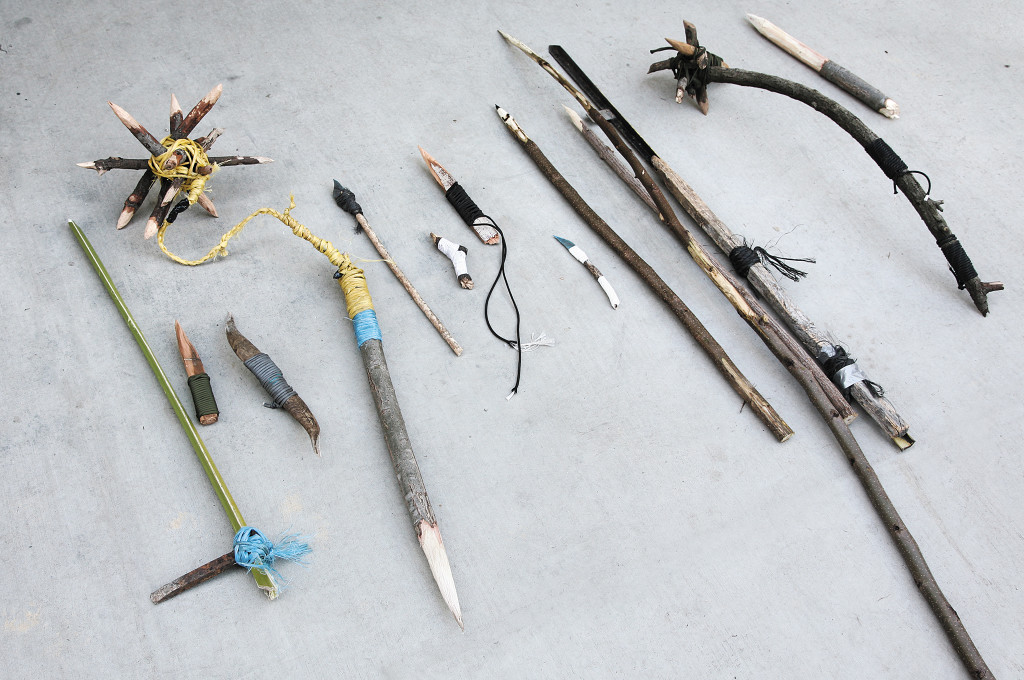
Here’s a small sample of a few improvised weapons created by untrained survivalists over the course of a few...
Stuck between a rock and a hard place, with all manner of predators (either the two-legged and four-legged variety)? The first step is to take in your surroundings and note what objects are available. Then consider whether those items can be crafted into three classes of improvised weapons: blunt-force, piercing, and projectile. Each category has its advantages and disadvantages:

Blunt-force weapons can be as simple as a rock lashed to a stick. However, don’t mistake their lack of complexity...
Blunt-Force Weapons: They’re exactly what they sound like — simple, no-nonsense, and absolutely devastating when used correctly. Channel your inner caveman, because the club is one of the most well-known weapons in this category. Maces, staves, batons, and knuckledusterswould also fall into this class, as do kali sticks (for those of you familiar with Filipino martial arts). In a wilderness setting, a solid tree branch would make an excellent blunt-force weapon, while an urban environment might furnish a pipe, 2×4, or even an actual hammer.
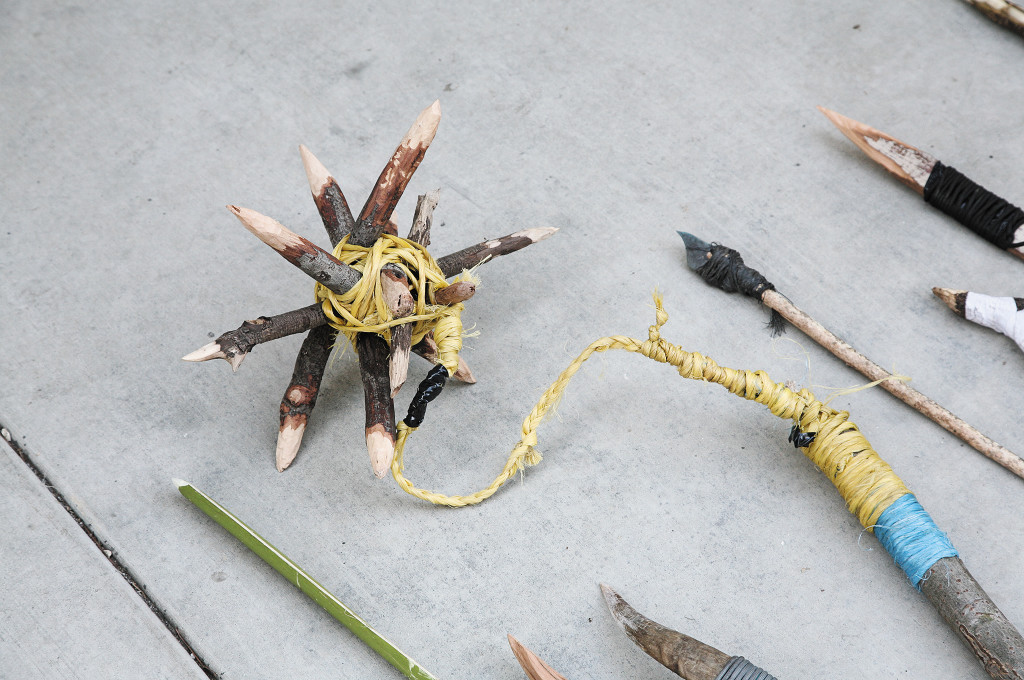
This improvised flail features sharp spikes lashed together and tethered to a handle, similar to designs used during...
Piercing Weapons: These are much more versatile for survival situations, but also more difficult to create. These weapons are designed to slash or stab, and include shivs, spears, pikes, knives, and swords. If you’re in an urban setting, you’ll be likely to find any manner of cutlery, scissors, or even a letter opener to use or modify into a spear. In the wilderness, a simple sharpened stick of any length is a tried-and-true implement of defense.
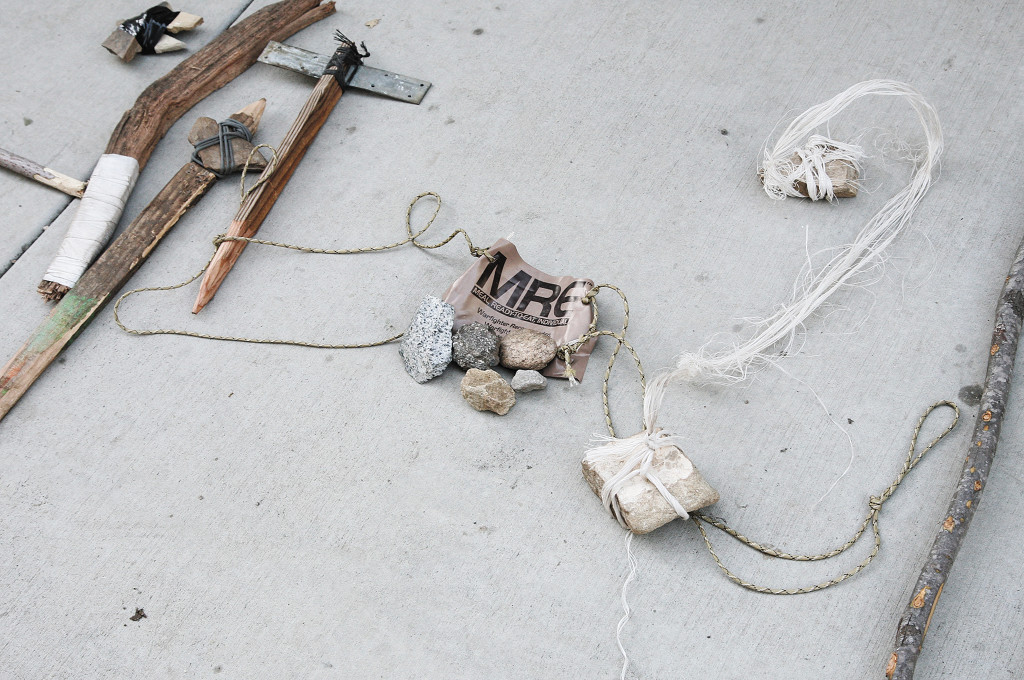
Projectile weapons, such as this MRE-pouch sling, have proven to be highly effective for both hunting and defense. On...
Projectile Weapons: These tools have better range, but are the most risky to use.Once you’ve used your weapon, you’re left defenseless while you reload, draw another weapon, or make your escape. However, with proper training, these weapons can be deadly. Included in this category are slings, bows, javelins, throwing knives, and bolas.
Keep in mind that any of these categories may be combined for added effectiveness. For example, a shovel, pickaxe, or hatchet would serve as an excellent hybrid of blunt-force and piercing. A tomahawk can be used for hacking and slashing, or thrown for added range. The more weapons you make, the more options you have. The possibilities are as limitless as your ingenuity.
Now that you’re aware of the differing weapon classes, on to the harder part: how to actually build one. These techniques, and your available resources, will vary greatly between urban and rural environments, so we will address both settings.
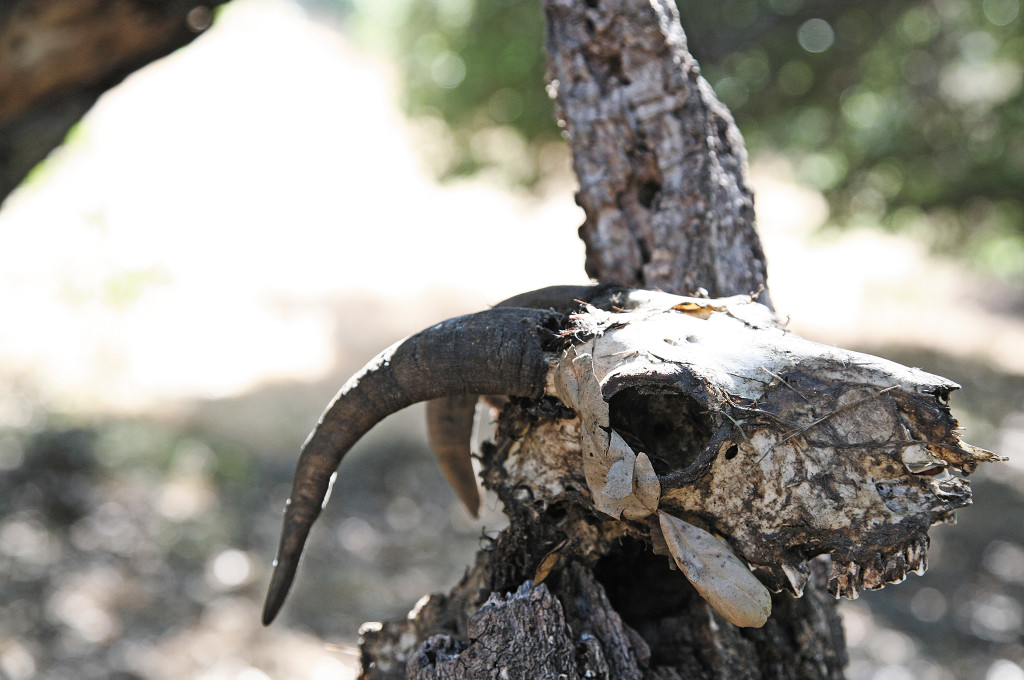
Rural environments require more creative use of materials. Bone is lightweight, strong, and easily sharpened, and has...
Urban environments (whether metropolises or small towns) are rife with all sorts of useful manmade materials. Building a weapon from scratch probably won’t be necessary here, seeing as how there are many preexisting weapons available — and we’re not even talking about guns and machetes. Crowbars, chef’s knives, baseball bats, and the like would be relatively easy to obtain. If you find yourself in a place devoid of any effective impromptu weapons and forced to create a more effective tool, plenty of building materials can be found in homes and businesses — duct tape, cable ties, baling wire, and even broken glass.
One key point to remember: In urban settings during a chaotic event, you’ll be more likely to run into other people carrying more formidable weapons or guns, making stealth a key to self-defense.
Rural or wilderness environments make it much more difficult to build improvised weapons, primarily due to the lack of manmade materials. Even finding something as simple as cordage to lash a club together can be a struggle. Your primary materials will be stone and wood, so think primitive. Clubs can be formed by lashing a rock to a branch with fibrous vines or bark strips. You can also use twine, paracord, or fabric from your own clothing — whatever is available will (have to) do.
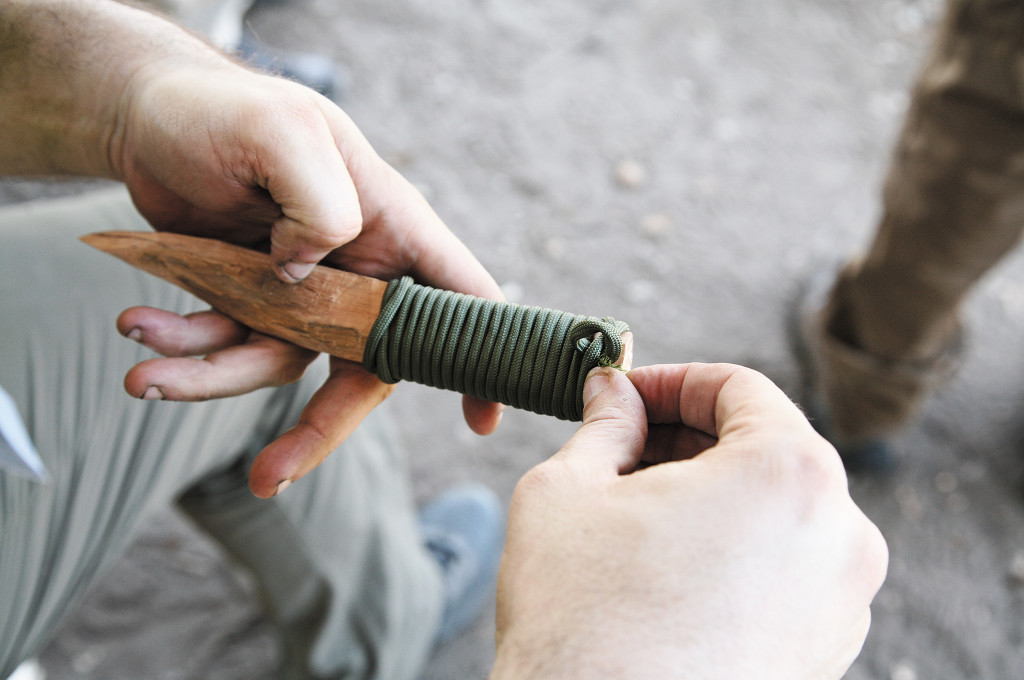
In addition to its obvious use as a binding agent, cordage can be used on weapon handles to provide additional grip and...
Barbed-wire fences can be a real asset, since the sharp wire can serve as both a binding agent and part of the weapon itself. Additionally, the thin stamped steel fence posts found in some areas can serve as a lightweight, strong weapon handle. Other materials to keep an eye out for include nails, bone, shells, and garbage. Something as innocuous as a discarded plastic bag can be repurposed into a sling pouch or cordage.
Many other weapons can be constructed quickly without complex tools. A spear can be formed by working the tip of a branch against a rock, or using a small knife if you happen to have one. If you’ve got a larger fixed-blade knife, just lash it to the end of a pole for added range. Even if you’re not in a wooded area, palm fronds or yucca stalks can be used in place of branches.
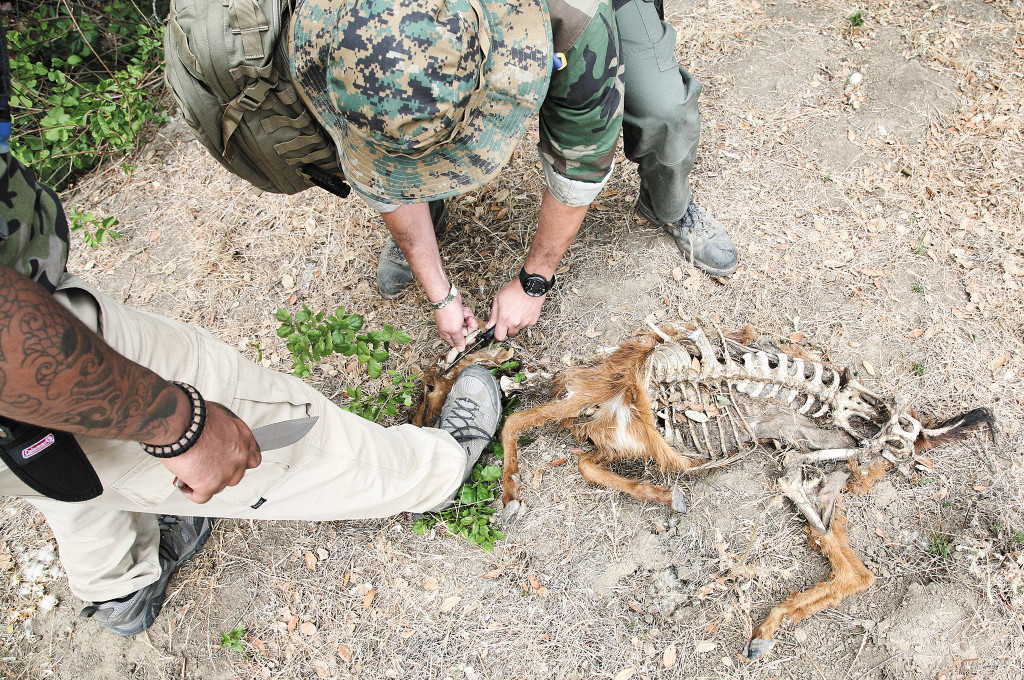
Look to nature for creative solutions. This goat carcass’s horn was broken off and repurposed into an imposing...
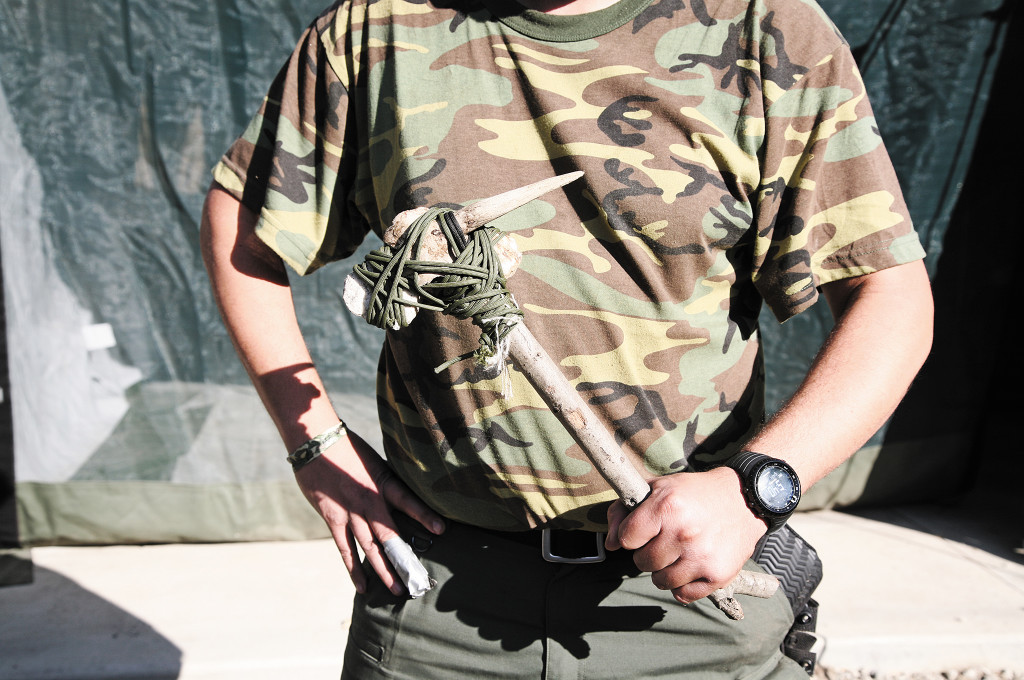
It may still seem unlikely that an improvised weapon would ever be used in modern combat, and we certainly hope that’s the case. However, it can and does happen in desperate situations. That’s why law enforcement groups worldwide study and document improvised weaponry. Criminals on the run sometimes resort to these tactics, and the fact that armed police officers take these weapons seriously shows their effectiveness.
Just as with any other type of weapon, the element of surprise can yield a major tactical advantage. If you feel threatened enough to use your improvised weapon, and can get the jump on your attacker, do so when possible. The last thing you want is to end up facing an armed aggressor head-on, or to end up outnumbered. Another factor to keep in mind is having a backup plan. Remember, if your primary weapon breaks, you don’t want to be left defenseless. Most importantly, know when to back down and when to stay hidden.
An improvised weapon will always be a last-ditch measure — one that you don’t want to test out unless you absolutely have to. The moral of this story is not to become a luddite and abandon modern weaponry. In fact, it’s wise to embrace the finest weapons the 21st century has to offer. Just don’t become overly reliant on this modern technology — you never know when you might be reduced to fighting with sticks and stones.
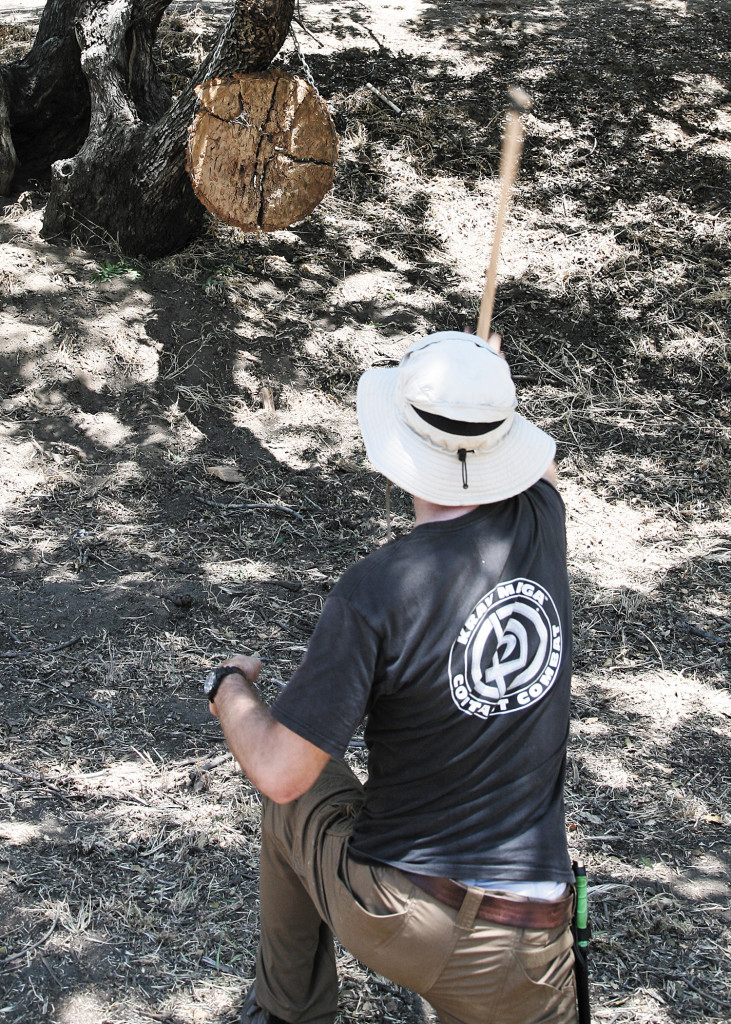
The key to success is practice. Learn to swing or throw your weapon with precision, and if you ever need to use it to...
Learning about ancient weaponry is crucial to creating effective implements of your own. Thousands of years of trial and error went into the designs of many so-called primitive weapons, and it would be foolish to disregard this knowledge.
Online encyclopedias have huge indexes of edged, blunt-force, and projectile weapon designs to study — or you could go old-school and visit your local library. Start with a simple design, and practice building it from materials commonly available in your area. Don’t go expecting to build yourself a crossbow under pressure.
Most importantly, learn how to use your weapon of choice as its originators intended. If you study the warfare of the past, you’ll be better prepared for anything that comes your way in the future.
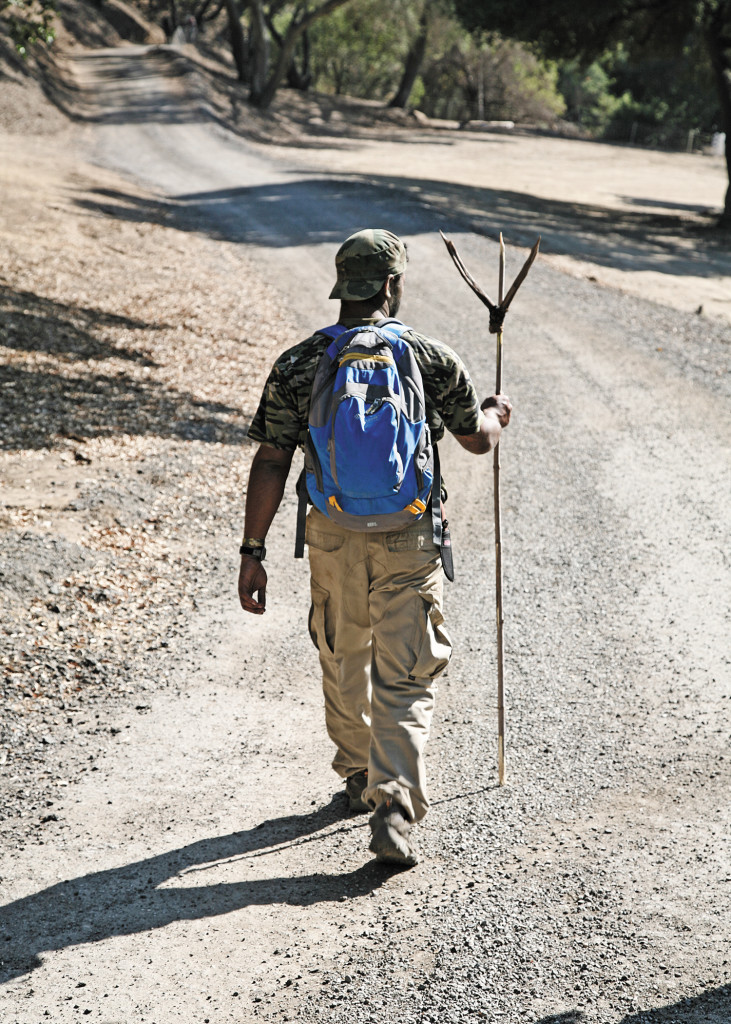
If you’re a fan of The Bourne Identity, you’ve probably never looked at a ballpoint pen the same way after watching the first installment of the movie franchise. In the 2002 original, the titular amnesiac spy (played by Matt Damon) dispatches various assassins with the help of all sorts of ordinary objects, including said pen.
Much of the innovative action came courtesy of fight choreographer Jeff Imada, a stuntman and martial artist who borrowed heavily from his background in both Jeet Kune Do (the system founded by Bruce Lee) and eskrima (a Filipino martial art). These systems emphasize adapting to your environment — and your opponent — using any and all means available to you. While eskrima is often considered a blade-and-stick art, its students can apply its combat principles using almost anything they can grasp. Pencils, umbrellas, and even this very magazine rolled up into a tube are potentially lethal improvised weapons in the hands of a skilled eskrima practitioner.
Your name doesn’t have to be Jason Bourne for you to develop competency in using everyday objects as self-defense tools. From handheld flashlights to scissors, ordinary items can make the difference between going bare-knuckled and having a distinct tactical advantage in an unexpected emergency.
— By Patrick Vuong
When you’re caged almost 24/7 for years on end, you have lots of time to ponder both your existence and your death. Therefore, prisoners often get quite creative when it comes to fashioning weapons. Here are three surprising types:
1) Powdered Non-Dairy Creamer Flamethrower: Yes, you read that right. Sodium aluminosilicate is an ingredient added to powdered creamer to keep it from caking. It also can become highly flammable when it is blown into an open flame. Place some creamer in a toilet paper tube, blow on one end with a lit lighter on the other. Voilà, flame on!
2) Chocolate Napalm: Melted chocolate sticks to the skin and is nearly impossible to get off before it scalds — causing serious burns, a lot of pain, and possible disfigurement or worse. Boil a Snickers bar for extra sticky caramel gooeyness.
3) Razor Blade Whip: Tie a shoelace to the end of a stick and, on the other end of the shoelace, string up several razor blades. There you go, a razor blade whip.
— By John Teator
Warning!
Making and using improvised weapons can be inherently dangerous and doing so is at your own risk.
 STAY SAFE: Download a Free copy of the OFFGRID Outbreak Issue
STAY SAFE: Download a Free copy of the OFFGRID Outbreak Issue
No Comments